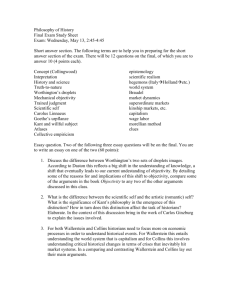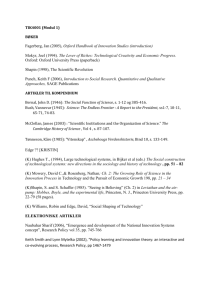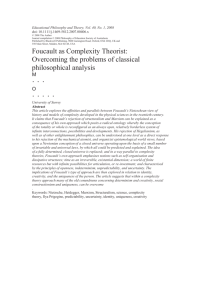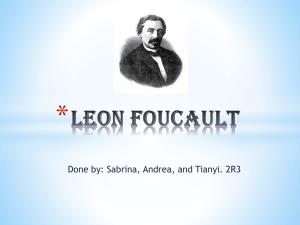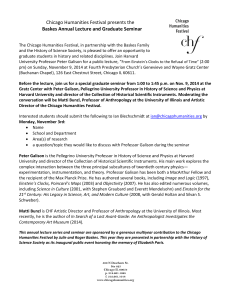Kaushik Sunder Rajan
advertisement
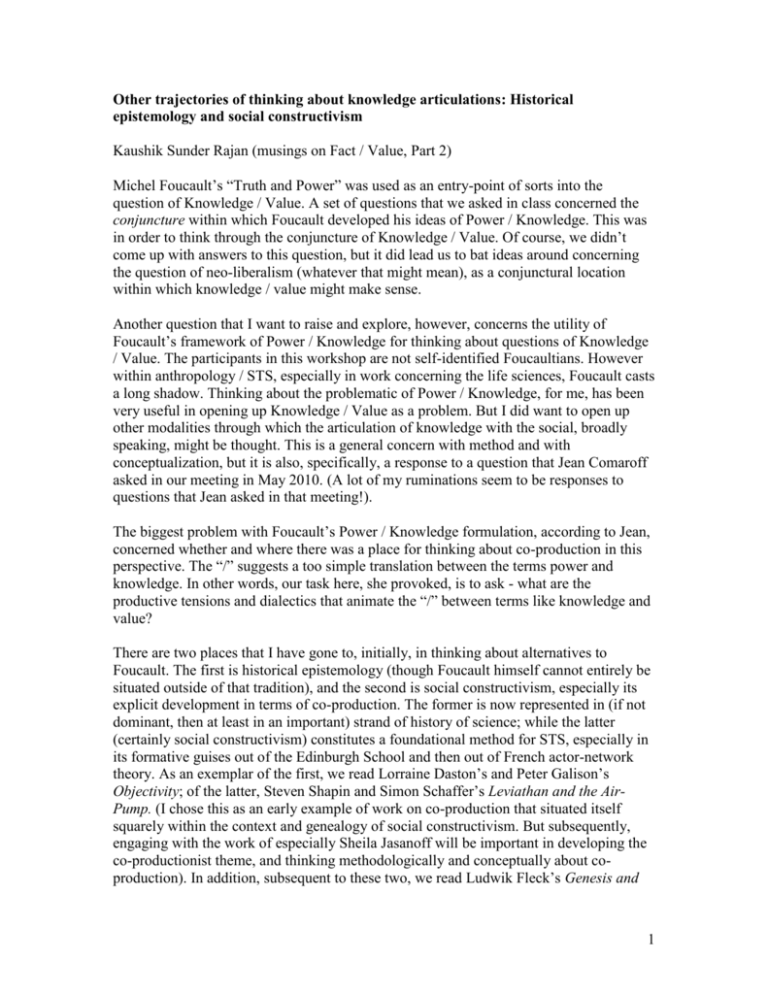
Other trajectories of thinking about knowledge articulations: Historical epistemology and social constructivism Kaushik Sunder Rajan (musings on Fact / Value, Part 2) Michel Foucault’s “Truth and Power” was used as an entry-point of sorts into the question of Knowledge / Value. A set of questions that we asked in class concerned the conjuncture within which Foucault developed his ideas of Power / Knowledge. This was in order to think through the conjuncture of Knowledge / Value. Of course, we didn’t come up with answers to this question, but it did lead us to bat ideas around concerning the question of neo-liberalism (whatever that might mean), as a conjunctural location within which knowledge / value might make sense. Another question that I want to raise and explore, however, concerns the utility of Foucault’s framework of Power / Knowledge for thinking about questions of Knowledge / Value. The participants in this workshop are not self-identified Foucaultians. However within anthropology / STS, especially in work concerning the life sciences, Foucault casts a long shadow. Thinking about the problematic of Power / Knowledge, for me, has been very useful in opening up Knowledge / Value as a problem. But I did want to open up other modalities through which the articulation of knowledge with the social, broadly speaking, might be thought. This is a general concern with method and with conceptualization, but it is also, specifically, a response to a question that Jean Comaroff asked in our meeting in May 2010. (A lot of my ruminations seem to be responses to questions that Jean asked in that meeting!). The biggest problem with Foucault’s Power / Knowledge formulation, according to Jean, concerned whether and where there was a place for thinking about co-production in this perspective. The “/” suggests a too simple translation between the terms power and knowledge. In other words, our task here, she provoked, is to ask - what are the productive tensions and dialectics that animate the “/” between terms like knowledge and value? There are two places that I have gone to, initially, in thinking about alternatives to Foucault. The first is historical epistemology (though Foucault himself cannot entirely be situated outside of that tradition), and the second is social constructivism, especially its explicit development in terms of co-production. The former is now represented in (if not dominant, then at least in an important) strand of history of science; while the latter (certainly social constructivism) constitutes a foundational method for STS, especially in its formative guises out of the Edinburgh School and then out of French actor-network theory. As an exemplar of the first, we read Lorraine Daston’s and Peter Galison’s Objectivity; of the latter, Steven Shapin and Simon Schaffer’s Leviathan and the AirPump. (I chose this as an early example of work on co-production that situated itself squarely within the context and genealogy of social constructivism. But subsequently, engaging with the work of especially Sheila Jasanoff will be important in developing the co-productionist theme, and thinking methodologically and conceptually about coproduction). In addition, subsequent to these two, we read Ludwik Fleck’s Genesis and 1 Development of a Scientific Fact. This is a fascinating text in many respects. While it argues, explicitly and foundationally, for an historical and comparative epistemology, it is also radically constructivist. Hence, it prefigures a number of distinct strands in STS and history of science today, and indeed the influences and residues of Fleck can be seen in a diversity of locations. Neither Objectivity nor Leviathan is explicitly or immediately political in the way that Foucault is, and Daston and Galison, in particular, are concerned with a history of science that tends towards being an internalist analysis. But they are both very important for thinking foundationally about the constitution of certain kinds of epistemic practices between the 17th and 19th centuries. They also allow us to think historically about the coconstitution of knowledge with value in these periods of time in Europe. In terms of historicizing the project of Knowledge / Value, especially in terms of thinking about the question of facticity, these two texts, I would argue, are of seminal importance. One of the things that Daston and Galison point to is the multiplicity of objectivity. They do so by generating a historical typology of all the things that objectivity has referred to over time, since the 14th century (when they record the earliest usage of the term in the European context), through the late 19th and early 20th century. They point out that the term drops out of usage for a couple of centuries after the 14th century before it is revived by Kant. But both the 14th century and the Kantian usages are quite different from how we might understand objectivity today. This more contemporary idea of the objective, they suggest, only emerges in the mid-to-late-19th century. Over a period of time, then, they point to a range of notions, where objectivity is defined as: something deeply sensory, and associated with one’s sensibilities; something deeply non-sensory, and located outside individual sensibilities; something interpretive; something individuated; something transcendent, that goes beyond the individual or particular representation. Regardless of what the specific notion of objectivity is, however, they suggest that it has always, throughout is historical usage, been coupled to a complementary idea of subjectivity. Hence, objectivity itself might have different meanings, but it has always been the oppositional counterpart of the subjective, which therefore also has correspondingly different meanings. There is no notion of the objective that is not in relation with the subjective. It is the 19th century forms of objectivity that Daston and Galison are primarily concerned with in their analysis. They are especially concerned with a form of objectivity, mechanical objectivity, which emerges only in the mid-to-late 19th century; but are also concerned with the forms of objectivity that immediately precede and follow this. The former is what they call truth-to-nature, and the latter trained judgment. They generate this typology by looking at an important representative form of the scientific image, the atlas illustration. 2 Simply put, truth-to-nature speaks to a regime of idealized representation. This is quite distinct from mechanical objectivity, but was an important pre-condition for mechanical objectivity to develop. Mechanical objectivity is not about idealization – the representation of a typical, idealized form that could generalize the characteristics of the object being represented – but about individuation. The purpose here was not to generalize, but to represent as accurately as possible individual objects – water droplets, snowflakes, organisms and their components – with all their particularities, peculiarities and asymmetries. Trained judgment, meanwhile, allows for certain kinds of “subjective smoothing” of representations by those who are expert enough to do so. It therefore speaks to a different kind of abstraction than that of the generalizing abstraction of truthto-nature representations. Trained judgment is one modality of representation that mechanical objectivity gives way to, in part because of its own perceived limitations. Another modality is that which attempts to do transcend representation altogether, through logic and mathematics. In the process of generating this typology, Daston and Galison work against the idea that objectivity is synonymous with scientific and political modernity. In the process, they are trying to tease apart a collapse that is often made between objectivity and quantification. (This is important to keep in mind, especially in the context of some of the texts we read in the class on the relationship between facticity and various forms of practices of quantification, such as statistics, accounting and modeling, especially the work of Ted Porter, Mary Poovey and Mary Morgan). They suggest that these are distinct epistemic virtues. (Indeed, one might perhaps situate various quantifying impulses within the trajectory of transcending visual representation altogether through logic and mathematics that Daston and Galison allude to). “Epistemic virtue” is an interesting phrase, immediately tying together the epistemic with a notion of ethos, and thereby opening up one modality by which to think of the articulation of knowledge and value. And that is what I want to hone in on and think further about. If one is to approach Objectivity in terms of value, then, the critical term is epistemic virtue, and thinking of that as a value-laden term becomes crucial. This is not simply an abstract concern – it is of direct consequence, in the mid-to-late 19th century, in polarizing the relationship of art to science (and of artists to scientists). The scientific illustration in the era of mechanical objectivity had, precisely, not to be art, with the abstractions and generalizations that the latter was necessarily thought to entail. The virtuous scientist was one who would not lend himself to such abstraction as the ideal artist would. Hence, one way in which epistemic virtue as a value-system parsed out was in terms of a vocational separation it created between the (ideal, virtuous) artist and the (ideal, virtuous) scientist. Therefore the idea of value is not just vocational, it is also embodied, in particular (ideal) types of individuals. Even if the artist and scientist possess different kinds of virtues (indeed virtues that might be considered vices in the domain of the other), there is a romantic, individualist virtuosity that is portrayed here. 3 (It is worth thinking here, as Meghan Morris pointed out in class, of how the late 19th and early 20th century was also the heyday of the patent emerging in its current form, closely coupled to the idea of the romantic author. Thinking of romantic individualist virtue as a form of value in relation to the patent is an important counterpoint to Daston’s and Galison’s portrayal of the romantic scientist. This is because Daston and Galison’s empirical entry point into science is the scientific atlas – theirs is a question of science as representational practice. Ultimately, at stake in all of truth-to-nature, mechanical objectivity and trained judgment, is fidelity to nature. It is just a question of what constitutes fidelity to nature, and how notions of the objective and subjective change in relation to these changing constitutions, which is at stake. But the patent opens up another dimension of scientific practice, concerning innovation). In reading Daston and Galison on its own terms, then, one confronts a notion of value in terms of epistemic virtue. But, as we discussed in the class, it is worth thinking of value in terms of both representation and innovation, both of which are important tropes and practices in science in the late 19th century. In terms of representation, one sees virtue in the self-denying, restrained scientist that Daston and Galison describe, the one who represents nature as is, without any abstraction, generalization or embellishment. In terms of innovation, one sees the importance of invention, and the trope of the scientist as romantic author. This is a particularly strong trope in late 19th century America. (Think here of Thomas Hughes on the history of innovation in America in American Genesis). In the latter context, what is at stake is not just romantic authorship, but authorship operating in the explicit context of regimes of value that are explicitly political economic, whether entrepreneurial or corporate, competitive or monopolistic. It would be interesting to think further about how to put these two value systems in conversation with one another in the context of the late 19th century. One certainly sees their explicit coming together in the 1980s in the US, with Ronald Reagan’s policy emphasis on innovation, legislative changes such as the Bayh-Dole Act, and the beginning of an explicit financialization of knowledge that has only increased in intensity over the past 30 years. In tracing the trajectory of the modes of intersection of different kinds of value systems over the past century of so – the epistemic virtues that Daston and Galison concern themselves with in relation to the more explicitly political economic values that arise from the understanding of the social and institutional contexts within which science operates – there is of course, also, a central importance of what Daston and Galison refer to as structural objectivity. This refers to the form of objectivity that is concerned primarily with the statistical; again, bringing in Porter’s work on the history of statistics and numerical representation into this context is very important. One way of thinking with and beyond Daston and Galison in terms of value, then, is to think about the internalization of value through its embodiment as epistemic virtue, in relation to its institutionalization – value at a more explicitly political economic register. A second way of doing so was suggested by Anna Weichselbraun in class: where the internalization of value as epistemic virtue might be thought in relation to the way in which scientific knowledge acquires value by virtue of its instrumentalization in public discourse. This, she pointed out, was particularly important in the US in the 1950s and 60s, in terms of the institutionalization of science education, but also in the context of the 4 atomic age and the Cold War. This speaks to another register of the externalization of value and of institutionalization, speaking to the Cold War state rather than to the market. Shapin and Schaffer For Shapin and Schaffer, also, value is related in significant ways to embodiment. But the specifics of this relationship are quite different than in Daston and Galison. This is partly because they are concerning themselves with a different moment in time, 17th century Restoration England. And partly because they are engaged with a different modality of scientific practice, the emergence of experiment as a foundationally authoritative form of scientific knowledge. Therefore, in reading Shapin and Schaffer, it is important, in part, to think about their methodological emphasis, which owes much to social constructivism. But it is also important to start thinking about the different forms of scientific knowledge production that might be at stake when we think about Knowledge / Value – at least, so far, the representational, the experimental, and the innovative. While there are registers of value at play in Leviathan and the Air-Pump, value is not the explicit consideration. (It is perhaps more explicit in Shapin’s article, “The House of Experiment in 17th century England”, which is worthwhile considering alongside Leviathan). Rather, what is primarily at stake for the authors is the mutually enforcing relationship between problems of knowledge and problems of social order. Yet in spite of this apparently quite Foucaultian concern, the authors tend to hardly use Foucault in their conceptualization. This is interesting, and it is worth exploring further whether, how and in what ways their methodology differs from Foucault’s. There are certain differences in the exact terms in which concerns about the social are articulated in Shapin and Schaffer compared to Foucault. Foucault is primarily concerned with how discursive practices create forms of power. For Shapin and Schaffer, however, social order operates at two quite distinct registers. One is at the level of social etiquette and virtue – the whole question of the gentleman in Restoration England, and the related issues of social standing and a quintessentially English notion of class. But there is also social order at the level of the functioning of the state and the operation of sovereign power that is at stake. In that sense, the social is articulated in precisely the kinds of macro-political terms that Foucault tries to work around; but that is a function, of course, of the subject matter that Shapin and Schaffer are writing about. It is impossible to write about Hobbes without considering macro-political questions of sovereign power, since that is precisely what Hobbes is so concerned with. Shapin and Schaffer are dealing with a foundational moment where questions of governance and political form are being laid bare. Knowledge production, at this time, is directly related to questions of the political. This brings up not just the question of sovereign power, but a crucial related question of what constitutes the public for this sovereign power. Central questions include who gets to be the authoritative producer of knowledge, as well as whose witnessing counts as credible. At a simple level, these questions can be answered in terms of a very English notion of class (and, as Donna Haraway would later argue in Modest Witness, of gender). But at a more conceptual 5 level, what is at stake is whether a public is constituted simply by credible witnesses (those who have the privilege and resulting authority to enter spaces like the Royal Society to watch experiments, and have their witnessing count). For Boyle, the answer was yes – experiments could not be legible to those who were not already credible as witnesses. But for Hobbes, it was precisely the fact that Boyle’s experiments were so restricted in terms of legibility that made them antithetical to a form of knowledge production that is truly open and public. Hobbes’ idea of the public then was one which could imagine universal assent; Boyle’s notion of the public was mediated through the creation of a particular community that could see for the public at large. On the one hand, therefore, there is a fundamental dispute being Boyle and Hobbes on what constitutes the public. On the other hand, there is a fundamental dispute regarding what constitutes truth. This latter dispute centers around the rather esoteric concern of horror vacui – the Aristotelian notion that nature abhors a vacuum. For Boyle, there is a factual answer to this question – vacuum exists because his air-pump experiments show that it does. But for Hobbes, there were problems with this. The first concerned how factual Boyle’s assertion was. This question of the factuality of the results of the airpump experiments are directly tied in to the question of witnessing and the public, since establishing factuality for Boyle depended upon the credible witnessing of those who were already deemed, in advance, to be credible witnesses. Hence, the content of fact was directly dependent on the notion of the public that existed to validate that fact. This is coproduction – there is no order of truth that is separable from the order of the social. Further, it is not the case that one pre-exists the other – the establishment of both is simultaneously at stake. One can perhaps see the subtle difference here from the Foucaultian perspective of truth’s disseminating effects on power. This speaks to Jean Comaroff’s suggestion of the seamlessness of translation between power and knowledge in Foucault, and a method of co-production as an alternative interpretive framework. But there is a second problem for Hobbes. This is a concern not just with the content of fact, but with factuality itself as the ground upon which truth-claims could be made. For Hobbes, truth was not based in the factual, but rather in the philosophical, in the domain of natural philosophy. Therefore, Hobbes and Boyle were also contesting the very relationship between fact and philosophy. For Hobbes, philosophy was primary and subsumed the factual. But Boyle was creating the domain of the factual (as experimental) as separate from the philosophical. And again, this could not be done without creating a concomitant social technology of assent – and necessarily creating an adequate public that would provide the appropriate assent. This assent was created through various types of technologies, which Shapin and Schaffer classify as material, social and literary. The literary technology, in particular, provides another site for Knowledge / Value articulation. What it allows for is a technology for virtual witnessing, where people at a distance who cannot see the experiment can nonetheless be made “present” through a reading of its textual representation. But necessary to an adequate textual representation there is the virtue of modesty. This opens up the notion of the modest witness as the legitimate observer of an experiment, in order to make it produce an experimental matter of fact. Here, as with 6 Daston and Galison, value operates at the register of individual, embodied (classed and gendered) epistemic virtue. The notion of fact, then, emerges as a particular kind of articulated entity in Shapin and Schaffer’s analysis. It comes to be at stake in a dual register – the question of what constitutes experimental fact is disputed, but so too is the question of the credibility of the factual itself. In the process, the notion of the fact gets articulated to questions of community on the one hand, and space on the other. The community is the (collective) body within which the fact resides as factual. But this collective body has to be constituted by individual bodies that are credible and virtuous in particular (modest) ways. What one sees here, potentially, is the early figuration of the notion of an expert community, which provides a source of social order and a relationship to sovereign power. (But again, it is a particular kind of expert community, one whose relation to authority is in terms of embodied epistemic virtue. As Ted Porter’s analysis of the costbenefit analysis in the US Army Corps of Engineers, and Sheila Jasanoff’s comparative studies of biotechnology regulation in the US, UK and Germany show, this kind of expert authority is not natural to science, or to fact, but is in fact culturally particular). Space meanwhile is related to the appropriate space within which an experiment can be publicly performed, and the space of the Royal Society becomes a very particular kind of public space in the context of which experimental fact can be produced. The relationship between experimental space and the creation of a representative public is one of the central ways in which the social is ordered in this analysis. Therefore, if Shapin and Schaffer are writing about a co-produced relationship between knowledge and social order, then both are at stake in particular ways. Social order in this case is, as just suggested, intimately tied in to different ideas of the public. Knowledge, meanwhile, involves the confrontation between epistemologies of experiment and of philosophy. A particular vehicle stands in for each – experimental knowledge depends upon experience, at a dual register. (One has to experience the experiment, either as a direct witness, or indirectly through the mediation of the literary technologies that disseminate it; but one also has to have the right experience to witness the experiment and to have it be legible in the right way). Philosophy, meanwhile, depended upon language. For Hobbes, as suggested, experience was never going to be a good enough basis for true knowledge, partly because the experience of experiment is never transparent enough to garner the kind of universal assent that Hobbes felt was essential for truth; and partly because what was at stake, ultimately, was not the demonstrability of things, but the ability to find the right language to describe the world. For him, that was the true task of philosophy. Each of these ideas of knowledge already has a particular kind of social order inscribed within it, because it is impossible to talk about knowledge in either of these registers without particular imaginations of the public already inherent. “Social order” then is not the outside, relational counterpart of the epistemic across which one can make conceptual translations; it is already integral to ways in which epistemology is at stake. There is no epistemology without a concomitant social order. Again, this is co-production. And along with the different kinds of social orders manifesting as different imaginations of the public are different mechanisms for enforcing the desired social order. As Shapin and Schaffer suggest on p. 105, the 7 experimental social order of Boyle is enforced through a system of internal moral control; Hobbes’ philosophical social order is enforced through behavioral control. There are three final points that I want to make about issues and stakes that emerge from Shapin and Schaffer. The first is to re-pose Jean Comaroff’s provocation to think about Foucault next to coproduction as different modalities of thinking across the “/” that lies at the heart of Power / Knowledge or Knowledge / Value. Is the co-production of knowledge and social order that Shapin and Schaffer describe different, methodologically, from the relationship Foucault posits between knowledge and power? I suspect that it is, though I would like to think through how, why and what the stakes are of this difference, especially in terms of developing a better understanding of the articulation of knowledge and value for our purposes. (Here, I think it is significant that Foucault needs to develop the notion of regime in order to talk about the Power / Knowledge relationship. The regime is the ensemble of institutions and discourses through which Power / Knowledge materializes). The second thing that I want to suggest is the importance of the materiality of the airpump itself in Shapin and Schaffer’s analysis. This is something that the authors themselves perhaps make less of than they might. But there is something about the fact that experimental knowledge is produced through the air-pump that is utterly important to the story – not least the fact that the air-pump leaks, and so being able to figure out the difference between an experimental result and an error caused due to faulty apparatus becomes critical (and ultimately is something that can only be resolved by taking recourse to social and value-laden factors that have to do with epistemic virtues such as credibility, modesty etc). This directly draws upon social constructivism, especially Harry Collins’ notion of experimenter’s regress which is one of the conceptual pillars of the social constructivist position. But, more generally, it points to the question of the material cultures of experimental science. This is something that is important for Ludwik Fleck, whose analysis of scientific fact is intimately tied in to the material technology the Wasserman reaction as a test for syphilis. And it becomes an extremely important site for historians of 20th century biology who write about experiment, such as Hans-Jorg Rheinberger. The third speculation I want to put up is the question of the relationship between epistemology and something that I would refer to in the broadest sense as democracy. Questions of the relationship between knowledge and social order are questions simultaneously of the appropriate definition of the public, of appropriate modes of social ordering, and of appropriately legitimate epistemologies for producing truth. Such questions are at the heart of conceptualizations of the democratic. This is certainly the case in the conjuncture of Restoration England, but it is also the case at a more general, methodological register – and indeed, these particular articulations are just as resonant in Jasanoff’s analysis of 1990s and 2000s regulatory policy in advanced liberal societies as they are in the context of 17th century England. In what ways does co-production allow us to think through questions of the democratic? I go back to the questions I posed a while ago at the end of my reading of Daston and Galison in this regard, asking of the 8 relationship between “the internalization of value through its embodiment as epistemic virtue, in relation to its institutionalization – value at a more explicitly political economic register”. Does co-production allow us a method to think through answers to such a question? And finally, what do questions of social order in general, and the democratic in particular, have to do with conceptualizations of value? Some of these questions can be pondered further through a closer reading of Porter and Jasanoff, two authors we have discussed in the class. I will elaborate upon this by reading them more closely (but am not sure that I will have the time to do so before the meeting!). 9
